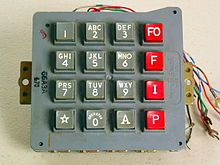Portal:Telephones

A telephone is a telecommunications device that permits two or more users to conduct a conversation when they are too far apart to be easily heard directly. A telephone converts sound, typically and most efficiently the human voice, into electronic signals that are transmitted via cables and other communication channels to another telephone which reproduces the sound to the receiving user. The term is derived from Ancient Greek: τῆλε, romanized: tēle, lit. 'far' and φωνή (phōnē, voice), together meaning distant voice. A common short form of the term is phone, which came into use early in the telephone's history.
In 1876, Alexander Graham Bell was the first to be granted a United States patent for a device that produced clearly intelligible replication of the human voice at a second device. This instrument was further developed by many others, and became rapidly indispensable in business, government, and in households. (Full article...)

A mobile phone (or cellphone) is a portable telephone that can make and receive calls over a radio frequency link while the user is moving within a telephone service area, as opposed to a fixed-location phone (landline phone). The radio frequency link establishes a connection to the switching systems of a mobile phone operator, which provides access to the public switched telephone network (PSTN). Modern mobile telephone services use a cellular network architecture, and therefore mobile telephones are called cellphones (or "cell phones") in North America. In addition to telephony, digital mobile phones support a variety of other services, such as text messaging, multimedia messaging, email, Internet access (via LTE, 5G NR or Wi-Fi), short-range wireless communications (infrared, Bluetooth), satellite access (navigation, messaging connectivity), business applications, payments (via NFC), multimedia playback and streaming (radio, television), digital photography, and video games. Mobile phones offering only basic capabilities are known as feature phones (slang: "dumbphones"); mobile phones that offer greatly advanced computing capabilities are referred to as smartphones. (Full article...)
A smartphone (often simply called a phone) is a mobile device that combines the functionality of a traditional mobile phone with advanced computing capabilities. It typically has a touchscreen interface, allowing users to access a wide range of applications and services, such as web browsing, email, and social media, as well as multimedia playback and streaming. Smartphones have built-in cameras, GPS navigation, and support for various communication methods, including voice calls, text messaging, and internet-based messaging apps. (Full article...)
Selected article -

Dual-tone multi-frequency signaling (DTMF) is a telecommunication signaling system using the voice-frequency band over telephone lines between telephone equipment and other communications devices and switching centers. DTMF was first developed in the Bell System in the United States, and became known under the trademark Touch-Tone for use in push-button telephones supplied to telephone customers, starting in 1963. DTMF is standardized as ITU-T Recommendation Q.23. It is also known in the UK as MF4.
Touch-Tone dialing with a telephone keypad gradually replaced the use of rotary dials and has become the industry standard in telephony to control automated equipment and signal user intent.Other multi-frequency systems are also used for signaling on trunks in the telephone network. (Full article...)Types of phones -

A courtesy telephone is a telephone located in airport terminals, large train stations, hotel lobbies, and other places where many travellers are expected, which is used to relay messages to a specific person.
It is typically used in connection with a public address system announcement of the style "Gwen Cooper, please pick up the nearest white courtesy telephone." Courtesy telephones may have a distinctive color, which is traditionally white in US airports, and most have no dialing capabilities but rather are simple ringdown stations to reach an operator or other fixed number. Some double as emergency telephones, having buttons by which a user can distinguish between emergency use and inquiry.
Customers can use a courtesy phone to seek information, such as where to find further transport or a person trying to meet them. Some courtesy phones provide a direct line to a number of advertised businesses, such as motels or taxis. They may be located near baggage claim, ticketing areas, and security checkpoints. (Full article...)Selected audio -
The off-hook tone (also off-hook warning, howling tone, or howler tone) is a telephony signal for alerting a user that the telephone has been left off-hook without use for an extended period, effectively disabling the telephone line. (Full article...)
List articles

- Comparison of smartphones
- List of best-selling mobile phones
- List of countries by number of broadband Internet subscriptions
- List of countries by number of telephone lines in use
- List of countries by smartphone penetration
- List of country calling codes
- List of iPhone models
- List of mobile network operators
- List of mobile phone brands by country
- List of mobile phone generations
- List of telecommunications companies
Related portals
General images -
Selected biography
Pat Trumble Fleet is an American voice actress. Widely recognized for the tens of thousands of recordings she has made for US telephone companies such as AT&T, Verizon, Qwest, the former Bell System companies, and others since 1981, she is still most recognized as the person who says "AT&T" in the company's sound trademark, which played prior to any operator assisted or credit card paid call, and on answer when calling AT&T customer service numbers.
She is also the voice for most "star" services (e.g. last-call return, call blocking, etc.) for AT&T local telephone companies, and the voice heard when making AT&T handled calls through 1-800-CALL-ATT (225-5288) and through international AT&T access numbers such as USADirect. (Full article...)Selected images
Topics
Subcategories

More
 |
Here are some tasks awaiting attention:
|
Telephones in the news
No recent news
Associated Wikimedia
The following Wikimedia Foundation sister projects provide more on this subject:
-
Commons
Free media repository -
Wikibooks
Free textbooks and manuals -
Wikidata
Free knowledge base -
Wikinews
Free-content news -
Wikiquote
Collection of quotations -
Wikisource
Free-content library -
Wikiversity
Free learning tools -
Wiktionary
Dictionary and thesaurus














































































































